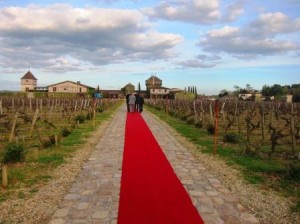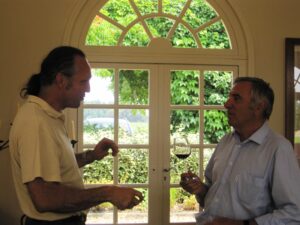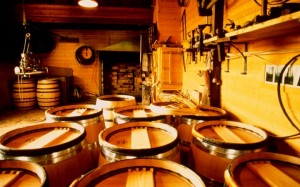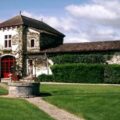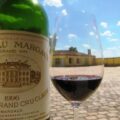Smith Haut Lafitte is not only making great white and red Bordeaux wine in Pessac Leognan, they are at the forefront with technology as well. They were one of first Bordeaux wine producers to begin using Optical Sorting, which came in handy with the difficult 2011 Bordeaux harvest. Fabien Teitgen, the long-time managing director joined us for a long, detailed conversation on what took place at Smith Haut Lafitte for the 2011 Bordeaux vintage.
Jeff Leve: With the vats fermenting, what vintage does 2011 Smith Haut Lafitte remind you of?
Fabien Teitgen “After the first vats tasting, I imagine a vintage as 2008 for the balance, concentration and power. But with better fat, volume and texture”.
Jeff Leve: How would you describe the style of 2011 Smith Haut Lafitte?
Fabien Teitgen “To my mind, 2011 is balanced with low pH and medium alcohol. So for those who picked at the right time, their wines will be balanced, with a good concentration and a good freshness. The 2011 Smith Haut Lafitte vintage is not so simple to handle.”
Jeff Leve: For Smith Haut Lafitte, or for Bordeaux wine in general?
Fabien Teitgen “I think we will find big differences between wines. The savoir faire of the vine growers and the wine makers will be essential. The two last vintages, Mother Nature was very kind to us. 2011 Smith Haut Lafitte is not exactly the same thing”.
Jeff Leve: The weather switched from cool to dry to cool to warm and dry in September. Were you able to take advantage of the burst of warmth and sunshine in September?
Fabien Teitgen “Those wonderful weather conditions helped us find very good maturity. Usually at the end of September, even if the weather is good, the temperature is cool and the evolution of maturity is very long. This year, in two days we had a very strong evolution of maturity. We were able to pick just after mid-September”.
Jeff Leve: What dates did you start and finish harvesting the fruit for your white 2011 Smith Haut Lafitte wine?
Fabien Teitgen “We picked” Sauvignon Blanc from August 18 to September 2. We harvested Sauvignon Gris starting August 28 and finished August 31. We finished with our Semillon, which we picked in one day, Septembe 9″.
Jeff Leve: What about for your red 2011 Smith Haut Lafitte wine?
Fabien Teitgen “We began with the Merlot September 9 and finished September 22. Petit Verdot only took one day, September 23. Cabernet Franc took place in a single day. The Cabernet Sauvignon harvest took place between September 24 and September 30”.
Jeff Leve: How did this early harvest affect you at Smith Haut Lafitte?
Fabien Teitgen “Because of the early harvest we imagine a “hot wine” this year. But it’s not the case. 2011 Smith Haut Lafitte is a fresh and balanced vintage that was picked very early. Paradoxical, isn’t it?”
Jeff Leve: That is a good point.
Fabien Teitgen “With our 2011 harvest, we harvested earlier because the growing of the vines was earlier than usual, due to the very hot spring. But the weather conditions of maturation in summer (July and August) were fresh and cool, so the wine is of a cooler style than a late vintage. The nice weather conditions at the end of August and September were very good for phenolic ripeness”.
Jeff Leve: What happened with the 2011 Bordeaux growing season to make it so unusual?
Fabien Teitgen “It was unique. We had summer in spring, spring in summer and a new summer in autumn. It was strange indeed. For the parcels with very deep roots we had no problems at all and the growing of the vines was good”.
Jeff Leve: Did the drought and stress present you with any unique challenges with the 2011 Bordeaux harvest?
Fabien Teitgen “It has been difficult with young vines in June because it was too dry. But I think the strong variations of weather all year long affected and stressed the vines. When the vines are stressed, they produce bigger quantities of polyphenol to fight this stress (and it’s good for us) but if the stress is too strong or too long, the vines stop protecting their own life. In those conditions the drought is negative. There is no evolution of maturity and the tannins stay green and dry”.
Jeff Leve: Which of your terroirs performed best in 2011?
Fabien Teitgen “This year, only vines with deep roots in great terroir were able to fight drought and stress in a positive way”.
Jeff Leve: Did your vines suffer from sunburn during the spring?
Fabien Teitgen “Yes some parcels suffered from sunburn. During the last week of June when we had two days with 40 degrees Celsius, some berries were burnt by the sun. This was the first effect we saw immediately. A few weeks later we saw that some other berries stopped their evolution and stayed green or pink”.
Jeff Leve: Did this happen with any specific grapes?
Fabien Teitgen “Mostly the Cabernet Sauvignon suffered, because their canopy is lighter”.
Jeff Leve: With the summer rains, did you have fears of rot?
Fabien Teitgen “We had fears of rot because with the sunburn in June and the wet weather in the second half of July, the skins became thinner. We began to see some small attacks of rot. With the rains of August, the conditions became wet and hot. We began to see some mildew or rot (in small quantities)”.
Jeff Leve: What did you do about it?
Fabien Teitgen “We have small yields, a small number of grapes on each vine and good aeration of the grapes. This gives us vines that are well balanced. Our soil also offers a good natural resistance. Organic growing gives more natural immunity. With mostly good weather conditions; the evolution of rot was not a real problem for the harvest at Smith Haut Lafitte”.
Jeff Leve: Did your use of satellite imagery help with the 2011 Bordeaux vintage?
Fabien Teitgen “Of course, with such an exuberant vintage the satellite imagery helped us harvest homogenous lots of grapes”.
Jeff Leve: How important was sorting for you in the vines and during harvest this year?
Fabien Teitgen “Sorting was one of the keys of the vintage. As I said before, there were many green or pink berries and there were many dry, small berries and insects. People who were not able to sort all these things out are not able to make great wines. There was too much pollution to make wine with good textures and precise aromatics.”
Jeff Leve: How big a role did optical sorting play for you with the 2011 Bordeaux vintage?
Fabien Teitgen “This year, the optical sorting machine was essential in the “reception” of the grapes in the cellar. It would have been very hard indeed to get rid of all the unwanted material by hand. We were pleased to have been pioneers in 2008 with this “pretty difficult to adjust” sophisticated machine”.
Jeff Leve: Did you also sort more by hand?
Fabien Teitgen “By now, we are better at using Optical Sorting. But the little pink or green berries were hard and sometimes bumping back on the table. 8 people worked to finish by hand to further improve the quality of the sorting. The machine did 95 % of the work. I thought that the 5 % was not acceptable for our wine. So we finished by hand with good results”.
Jeff Leve: What yields do you expect this year?
Fabien Teitgen “For the white perhaps 10 % less than last year and for the red I could not say exactly because we are in maceration, but we picked 10-15 % less than last year”.
Jeff Leve: What specific choices will you need to make during the vinification 2011?
Fabien Teitgen “We need to be delicate in the long, soft, extraction to choose what we want to extract to avoid bitter and green tannins which could have developed in some of the seeds, due to the cooler growing season”.
Jeff Leve: Can you please share some technical information about your potential alcohol levels and pH numbers?
Fabien Teitgen “Merlot: 13.5-14%vol, 3.6-3.65 pH (before malolactic fermentation), Total acidity 4-4.5 g/l H2SO4. For the Cabernet: 13%vol, 3.7 pH (before malolactic fermentation), Total acidity 4.5-5 g/l H2SO4”.

